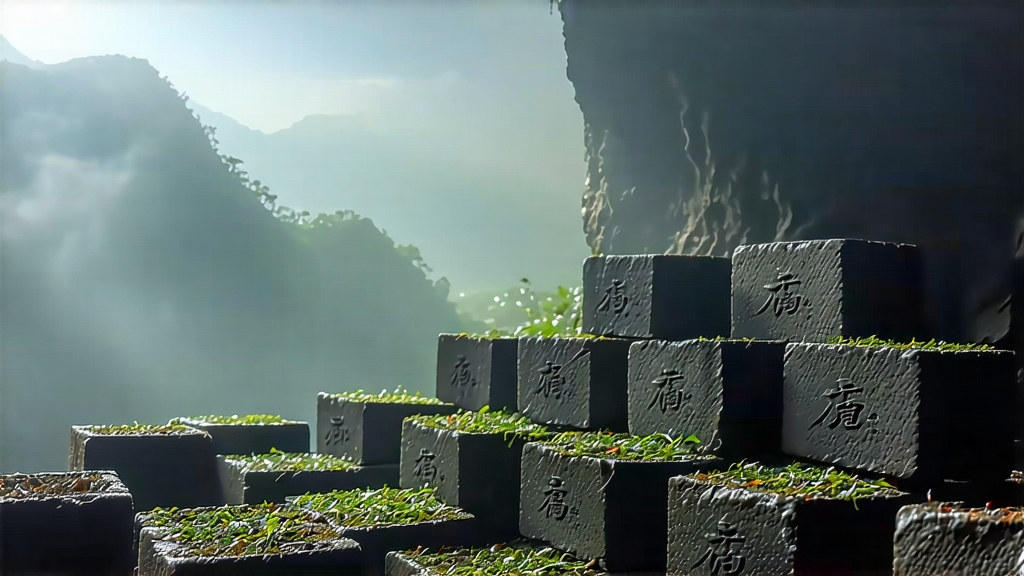
Tucked beneath the humid karst hills of Guangxi, where the Xun and Gui Rivers braid themselves around the city of Wuzhou, a tea has been quietly fermenting for centuries. International drinkers may speak of Pu-erh with reverence, yet few have heard of Liupu—an even darker, more subterranean sibling that slumbered in limestone caves long before European cellars ever cradled wine. Liupu is not merely a beverage; it is a time capsule whose leaves remember the scent of torch-smoke, river fog, and the slow drip of cave water. To understand it is to step into a micro-climate where geology, commerce, and patience conspire to turn coarse subtropical leaves into liquid obsidian.
Historical whispers place Liupu on merchant rafts during the Tang dynasty, when Yao and Han traders poled down-river to Guangzhou. The tea took its name from Liupu village, once a tidal anchorage where sails were furled and cargo re-sorted. Jute-wrapped bricks, pressed for easier taxation, absorbed bilge water and river vapors, arriving at the wharf darker and smoother than when they left. By the Qing, Liupu had become “medicine for the southern barbarians,” prescribed for fever, indigestion, and the malarial damp that clung to foreign trading posts. British and Dutch records list it as “Lieu-Poo” beside invoices for cassia and star anise, proof that the tea crossed oceans while Europe was still flirting with Indian Assam.
Today Liupu is protected under China’s National Geographical Indication, restricted to the three counties of Cangwu, Tengxian, and Mengshan. Within this tiny radius two leaf styles dominate: the traditional “san cha,” a loose, twiggy grade sold by weight to teahouses, and the modern “zhuan cha,” a 1-kilogram brick stamped with the character 茶 in vermilion ink. A third, rarer form, the “hua zhuan,” embeds tiny golden flowers of Eurotium cristatum—the same probiotic mold celebrated in Hunan’s Fu brick—creating a freckled surface that looks like leopard skin. Each style is built from a four-grade leaf set: tips for sweetness, the second leaf for body, the third for mineral bite, and stems for a camphor finish that later echoes in the cup.
Craft begins on the rainy eve of the Grain in Ear solar term. Pickers climb 300-year-old shrubs that grow out of limestone fissures, their roots sipping calcium-rich water. The leaves are wilted under banana leaves for two hours, then “killed green” at 280 °C for exactly 240 seconds—long enough to freeze the green enzymes yet short enough to keep a sliver of moisture for later microbial drama. Rolling is done barefoot on bamboo trays; the sole’s gentle pressure bruises cells without crushing veins, releasing a grassy sap that will oxidize into cocoa. After a brief sun-dry the maocha is steamed, piled into 60-kilogram heaps, and covered with wet gunny sacks. Inside this compost-like mound thermophilic bacteria raise the core to 55 °C for ten days, converting catechins into theaflavins and birthing a mushroomy aroma locals call “wet cellar.” The final, decisive step is cave aging. Bricks are carried to natural karst chambers where relative humidity hovers at 88 % and temperature stays a constant 22 °C year-round. Over months the tea breathes calcium carbonate, its surface silvering with frost-like bloom while interior enzymes continue a slow, almost geological fermentation. A five-year brick weighs 30 grams less than a newborn one—evaporation of soul, farmers joke—yet the liquor gains a ruby translucence impossible to replicate in above-ground warehouses.
To brew Liupu is to negotiate between its dual personalities: the polite, honeyed surface and the feral, camphor undercurrent. Gongfu style is recommended, but with larger vessels to accommodate the tea’s density. Begin by rinsing 8 grams of broken brick once with 95 °C water, discarding the flash infusion to wake the leaves. The first proper steep lasts 15 seconds; pour in a high, thin stream to aerate and soften tarry notes. Liquor emerges the color of Shanxi aged vinegar, yet smells of dried longan and river stone. Second steep stretches